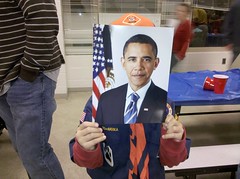 According to USA Today, the 2010 Census will
According to USA Today, the 2010 Census will
remind Americans that racial classifications remain an integral part of the country’s social and legal fabric while, at the same time, recognizing that racial lines are blurring for a growing number of people…The government will give the nation’s more than 308 million people the opportunity to define their racial makeup as one race or more.
Some suggest that Obama’s presidency may affect how individuals report their race this time around. But how Obama himself will record his race remains a mystery.
Obama, born to a black father and a white mother, is not only the first black president but the first biracial president.
During his successful campaign in 2008, Obama referred to himself as black but also referred to his roots in Hawaii, where he was raised by his white mother. When the Obamas’ Census form arrives at 1600 Pennsylvania Ave., will he identify himself as black or as black and white? The White House declines to say.
A sociologist weighs in:
“The issue of perception is central,” says Ann Morning, a sociology professor at New York University. In an article titled “Who is Multiracial?” she estimated that about one-third of the U.S. population has some mixed-racial ancestry going back several generations. She predicts young generations will be more embracing of their multiracial heritage.
Morning is African American. But she also has English, Chinese and American Indian ancestry. Since 2000, she has checked off black, white, Asian and American Indian.
“The bigger thing is how I will mark my daughters,” Morning says. Their dad is Italian and she believes most people will look at her daughters as white. For now, she’ll check all the boxes for them, too.
Some question whether counting race is a good idea at all.
Roderick Harrison, a demographer at Howard University and the Joint Center for Political and Economic Studies in Washington. “But for a lot of others, it’s like, ‘OK, are you going to turn your back on the rest of us?’ … A lot of the racial and ethnic politics of the Census are that we want the biggest numbers possible for our groups.”
The Census has a long-lasting effect on politics and money. Population counts every 10 years decide the number of seats every state gets in the U.S. House of Representatives and determine how more than $400 billion a year in federal aid is allocated.
“I know it’s valuable information if you’re doing economic development or dispense certain amount of money to areas that need it,” says Stewart Cockburn, 39, who lost his job in textile sales in September. “My point about race in general in this country is that we’re just never going to get past it if we keep asking about it.”
Cockburn, of Greensboro, N.C., says he’s Scottish and Irish and has a great-grandmother who was Cherokee.
“I don’t understand why everyone makes such a big deal about race,” he says. “Maybe one day we will no longer care about race, ethnicity or the color of another person’s skin.”
Donna Edwards, of Santa Monica, Calif., says it’s important that the federal government allows people to identify more than one race. “It’s about time, isn’t it?” says Edwards, who is half Japanese and half German/Scottish/Welsh and spent years frustrated by forms that boxed her into one or the other.






 According to the
According to the